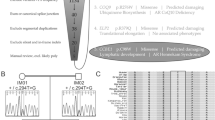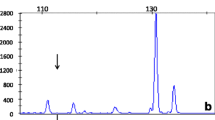Abstract
Collagen and calcium-binding EGF domain-containing protein 1 (CCBE1) bi-allelic mutations have been associated with syndromes of widespread congenital lymphatic dysplasia, including Hennekam Syndrome (HS). HS is characterized by lymphedema, lymphangiectasia, and intellectual disability. CCBE1 encodes a putative extracellular matrix protein but the HS-causing mutations have not been studied biochemically. We report two HS siblings, born to consanguineous parents of Turkish ancestry, whose clinical phenotype also includes protein losing enteropathy, painful relapsing chylous ascites, and hypogammaglobulinemia. We identified by whole exome and Sanger sequencing the homozygous CCBE1 C174Y mutation in both siblings. This mutation had been previously reported in another HS kindred from the Netherlands. In over-expression studies, we found increased intracellular expression of all forms (monomers, dimers, trimers) of the CCBE1 C174Y mutant protein, by Western blot, despite mutant mRNA levels similar to wild-type (WT). In addition, we detected increased secretion of the mutant CCBE1 protein by ELISA. We further found the mutant and WT proteins to be evenly distributed in the cytoplasm, by immunofluorescence and confocal microscopy. Finally, we found a strong decrease of lymphatic vessels, with a corresponding diminished expression of CCBE1, by immunohistochemistry of the patients’ intestinal biopsies. In contrast, mucosal blood vessels and muscularis mucosae showed normal CCBE1 staining. Our findings show that the mutant CCBE1 C174Y protein is not loss-of-function by loss-of-expression.







Similar content being viewed by others
References
Hennekam RC, Geerdink RA, Hamel BC, Hennekam FA, Kraus P, Rammeloo JA, et al. Autosomal recessive intestinal lymphangiectasia and lymphedema, with facial anomalies and mental retardation. Am J Med Genet. 1989;34(4):593–600.
Al-Gazali LI, Hertecant J, Ahmed R, Khan NA, Padmanabhan R. Further delineation of Hennekam syndrome. Clin Dysmorphol. 2003;12(4):227–32.
Bellini C, Mazzella M, Arioni C, Campisi C, Taddei G, Toma P, et al. Hennekam syndrome presenting as nonimmune hydrops fetalis, congenital chylothorax, and congenital pulmonary lymphangiectasia. Am J Med Genet A. 2003;120A(1):92–6.
Connell F, Kalidas K, Ostergaard P, Brice G, Homfray T, Roberts L, et al. Linkage and sequence analysis indicate that CCBE1 is mutated in recessively inherited generalised lymphatic dysplasia. Hum Genet. 2010;127(2):231–41.
Cormier-Daire V, Lyonnet S, Lehnert A, Martin D, Salomon R, Patey N, et al. Craniosynostosis and kidney malformation in a case of Hennekam syndrome. Am J Med Genet. 1995;57(1):66–8.
Forzano F, Faravelli F, Loy A, Di Rocco M. Severe lymphedema, intestinal lymphangiectasia, seizures and mild mental retardation: further case of Hennekam syndrome with a severe phenotype. Am J Med Genet. 2002;111(1):68–70.
Gabrielli O, Catassi C, Carlucci A, Coppa GV, Giorgi P. Intestinal lymphangiectasia, lymphedema, mental retardation, and typical face: confirmation of the Hennekam syndrome. Am J Med Genet. 1991;40(2):244–7.
Scarcella A, De Lucia A, Pasquariello MB, Gambardella P. Early death in two sisters with Hennekam syndrome. Am J Med Genet. 2000;93(3):181–3.
Van Balkom ID, Alders M, Allanson J, Bellini C, Frank U, De Jong G, et al. Lymphedema-lymphangiectasia-mental retardation (Hennekam) syndrome: a review. Am J Med Genet. 2002;112(4):412–21.
Yasunaga M, Yamanaka C, Mayumi M, Momoi T, Mikawa H. Protein-losing gastroenteropathy with facial anomaly and growth retardation: a mild case of Hennekam syndrome. Am J Med Genet. 1993;45(4):477–80.
Alders M, Hogan BM, Gjini E, Salehi F, Al-Gazali L, Hennekam EA, et al. Mutations in CCBE1 cause generalized lymph vessel dysplasia in humans. Nat Genet. 2009;41(12):1272–4.
Alders M, Mendola A, Ades L, Al Gazali L, Bellini C, Dallapiccola B, et al. Evaluation of clinical manifestations in patients with severe lymphedema with and without CCBE1 mutations. Mol Syndromol. 2013;4(3):107–13.
Alders M, Al-Gazali L, Cordeiro I, Dallapiccola B, Garavelli L, Tuysuz B, et al. Hennekam syndrome can be caused by FAT4 mutations and be allelic to Van Maldergem syndrome. Hum Genet. 2014;133(9):1161–7.
Bos FL, Caunt M, Peterson-Maduro J, Planas-Paz L, Kowalski J, Karpanen T, et al. CCBE1 is essential for mammalian lymphatic vascular development and enhances the lymphangiogenic effect of vascular endothelial growth factor-C in vivo. Circ Res. 2011;109(5):486–91.
Jeltsch M, Jha SK, Tvorogov D, Anisimov A, Leppanen VM, Holopainen T, et al. CCBE1 enhances lymphangiogenesis via A disintegrin and metalloprotease with thrombospondin motifs-3-mediated vascular endothelial growth factor-C activation. Circulation. 2014;129(19):1962–71.
Hogan BM, Bos FL, Bussmann J, Witte M, Chi NC, Duckers HJ, et al. Ccbe1 is required for embryonic lymphangiogenesis and venous sprouting. Nat Genet. 2009;41(4):396–8.
Shah S, Conlin LK, Gomez L, Aagenaes O, Eiklid K, Knisely AS, et al. CCBE1 mutation in two siblings, one manifesting lymphedema-cholestasis syndrome, and the other, fetal hydrops. PLoS One. 2013;8(9):e75770.
Mendola A, Schlogel MJ, Ghalamkarpour A, Irrthum A, Nguyen HL, Fastre E, et al. Mutations in the VEGFR3 signaling pathway explain 36% of familial lymphedema. Mol Syndromol. 2013;4(6):257–66.
Le Guen L, Karpanen T, Schulte D, Harris NC, Koltowska K, Roukens G, et al. Ccbe1 regulates Vegfc-mediated induction of Vegfr3 signaling during embryonic lymphangiogenesis. Development. 2014;141(6):1239–49.
Weijts BG, van Impel A, Schulte-Merker S, de Bruin A. Atypical E2fs control lymphangiogenesis through transcriptional regulation of Ccbe1 and Flt4. PLoS One. 2013;8(9):e73693.
Ingle SB, Hinge Ingle CR. Primary intestinal lymphangiectasia: minireview. World J Clin Cases. 2014;2(10):528–33.
Vignes S, Bellanger J. Primary intestinal lymphangiectasia (Waldmann’s disease). Orphanet J Rare Dis. 2008;3:5.
Bolze A, Byun M, McDonald D, Morgan NV, Abhyankar A, Premkumar L, et al. Whole-exome-sequencing-based discovery of human FADD deficiency. Am J Hum Genet. 2010;87(6):873–81.
Byun M, Abhyankar A, Lelarge V, Plancoulaine S, Palanduz A, Telhan L, et al. Whole-exome sequencing-based discovery of STIM1 deficiency in a child with fatal classic Kaposi sarcoma. J Exp Med. 2010;207(11):2307–12.
UniProt C. UniProt: a hub for protein information. Nucleic Acids Res. 2015;43(Database issue):D204–12.
Adzhubei IA, Schmidt S, Peshkin L, Ramensky VE, Gerasimova A, Bork P, et al. A method and server for predicting damaging missense mutations. Nat Methods. 2010;7(4):248–9.
Kircher M, Witten DM, Jain P, O’Roak BJ, Cooper GM, Shendure J. A general framework for estimating the relative pathogenicity of human genetic variants. Nat Genet. 2014;46(3):310–5.
Kumar P, Henikoff S, Ng PC. Predicting the effects of coding non-synonymous variants on protein function using the SIFT algorithm. Nat Protoc. 2009;4(7):1073–81.
Itan Y, Shang L, Boisson B, Patin E, Bolze A, Moncada-Velez M, et al. The human gene damage index as a gene-level approach to prioritizing exome variants. Proc Natl Acad Sci USA. 2015;112(44):13615–20.
Conley ME, Casanova JL. Discovery of single-gene inborn errors of immunity by next generation sequencing. Curr Opin Immunol. 2014;30:17–23.
Casanova JL, Conley ME, Seligman SJ, Abel L, Notarangelo LD. Guidelines for genetic studies in single patients: lessons from primary immunodeficiencies. J Exp Med. 2014;211(11):2137–49.
Roukens MG, Peterson-Maduro J, Padberg Y, Jeltsch M, Leppanen VM, Bos FL, et al. Functional dissection of the CCBE1 protein: a crucial requirement for the collagen repeat domain. Circ Res. 2015;116(10):1660–9.
Connell FC, Kalidas K, Ostergaard P, Brice G, Murday V, Mortimer PS, et al. CCBE1 mutations can cause a mild, atypical form of generalized lymphatic dysplasia but are not a common cause of non-immune hydrops fetalis. Clin Genet. 2012;81(2):191–7.
Acknowledgments
We warmly thank the patients for their participation. This work was supported by the National Center for Research Resources and the National Center for Advancing Sciences (NCATS) of the National Institutes of Health (NIH) (grant 8UL1TR000043), the Rockefeller University, INSERM, Paris Descartes University, and the St. Giles Foundation.
Author information
Authors and Affiliations
Corresponding author
Ethics declarations
Conflict of Interest
The authors declare they have no competing financial interests. All procedures performed in studies involving human participants were in accordance with the ethical standards of the institutional and/or national research committee and with the 1964 Helsinki declaration and its later amendments or comparable ethical standards. Informed consent was obtained from all individual participants included in the study.
Rights and permissions
About this article
Cite this article
Jackson, C.C., Best, L., Lorenzo, L. et al. A Multiplex Kindred with Hennekam Syndrome due to Homozygosity for a CCBE1 Mutation that does not Prevent Protein Expression. J Clin Immunol 36, 19–27 (2016). https://doi.org/10.1007/s10875-015-0225-6
Received:
Accepted:
Published:
Issue Date:
DOI: https://doi.org/10.1007/s10875-015-0225-6




